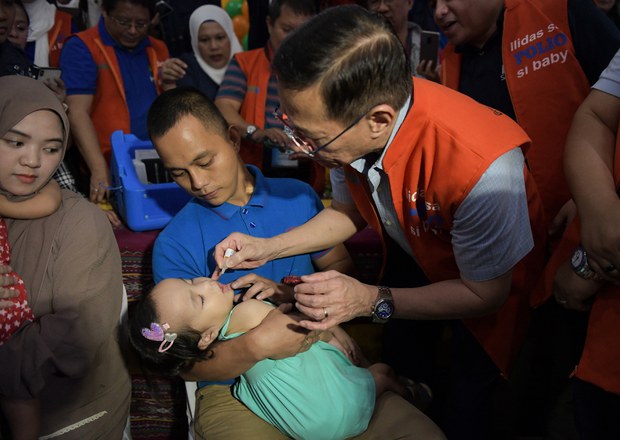UN Declares Polio Outbreak in Philippines Over
2021.06.11
Manila and Cagayan de Oro, Philippines
 Health Secretary Francisco Duque III gives a dose of the oral polio vaccine (OPV) to a child in Marawi, southern Philippines, Oct. 14, 2019.
Health Secretary Francisco Duque III gives a dose of the oral polio vaccine (OPV) to a child in Marawi, southern Philippines, Oct. 14, 2019.
The United Nations declared Friday that the Philippines beat back a polio outbreak two years after the Southeast Asian nation detected cases in small children, although the potentially crippling disease had mostly been eradicated worldwide.
Philippine health authorities went into emergency-containment mode, working with U.N. agencies the World Health Organization (WHO) and UNICEF to carry out a polio inoculation campaign after the first cases of the disease since 2000 emerged here in late 2019. Cases were then detected in toddlers in southern Lanao del Sur province and in Laguna province, near Manila.
According to a joint statement issued by WHO and UNICEF, the Philippine Department of Health (DOH) concluded its response to the polio outbreak on June 3. The outbreak had ended because the virus had not been detected in a child or the environment during the past 16 months, the U.N. agencies said.
“This is a major win for public health and is an excellent example of what collective efforts can attain, even amid the COVID-19 pandemic,” said Dr. Rabindra Abeyasinghe, the WHO’s representative in the Philippines.
“The closure of the polio outbreak is a direct result of strong political will and government leadership, the mobilization and engagement of resources and communities, the courage and the commitment of healthcare and front-line workers, and the combined, coordinated efforts of the local governments and partners,” he added.
The last known case of wild poliovirus in the Philippines was recorded back in 1993, according to WHO. In 2000, the United Nations declared the Philippines polio-free.
After the discovery in 2019 of new cases of polio – which can cause nerve injury and paralysis – the health department mounted an aggressive vaccination campaign nationwide with the help of U.N. agencies and other partners.
Seventeen confirmed cases of polio were recorded from 2019 to 2020 but there were no deaths, according to the health department.
“UNICEF celebrates all the vaccine champions and partners who made this possible. We must keep the momentum and accelerate routine immunization and safeguard essential child health services while rolling out COVID-19 vaccines for priority groups,” said Oyunsaikhan Dendevnorov, the country representative for the U.N. children’s agency.
Symptoms of polio include fever, fatigue, headache, vomiting, stiff neck, and the sudden onset of weakening of the arms and legs. A severe case of infections among children aged five and younger can lead to paralysis or even death in rare cases, the WHO said.
An oral polio vaccine was introduced in 1988, and millions of people around the world have averted death or infections because of it, experts said. The vaccine contains a weakened form of the virus and activates a body’s protective response to polio.
“This triumph we have achieved only goes to show that vaccines are safe and effective,” Philippine Health Undersecretary Myrna Cabotaje told reporters.
“It is for this reason that we continue to encourage the public to receive vaccines, not just the polio vaccine but other vaccines as well, including the COVID-19 vaccine,” she said.
Jeoffrey Maitem contributed to this report from Cotabato City, Philippines.







